- Frymaster Parts Guide - December 31, 2021
- Best Vulcan Fryer Guide For The Commercial Place - November 26, 2021
- Robot Coupe Food Processor Model Guide - November 16, 2021
Your first time behind a bar can be confusing. All that shiny, silver equipment; different spoons, measuring tools with funny names, contraptions you’ve never heard of before, just to make a few cocktails? Surely it’s not all necessary?
Well, when it comes to bartending, the equipment is incredibly important. Some drinks require a certain spoon, or the ice to be crushed in a particular way.
Plus, the bar is usually the centerpiece of any night out or party. A good bar can be the difference between people enjoying themselves or leaving early. And this blog post is here to make sure you know exactly what you need to make people stay.
We will be covering everything from how to set up your perfect bar and what bartending equipment you need to ordering the best types of glassware and stocking up on spirits! But, whilst modern bartending is something of an art, it didn’t use to be quite so spectacular.
The History of Bartending
The history of bartending dates back to Ancient Greece and Rome. In the past, bartending equipment was only used by wealthy people for party-exclusive use, put in place by expert craftsmen. These ‘bartenders’ typically brewed their own ale and spirits and were more commonly known as innkeepers than barmen.
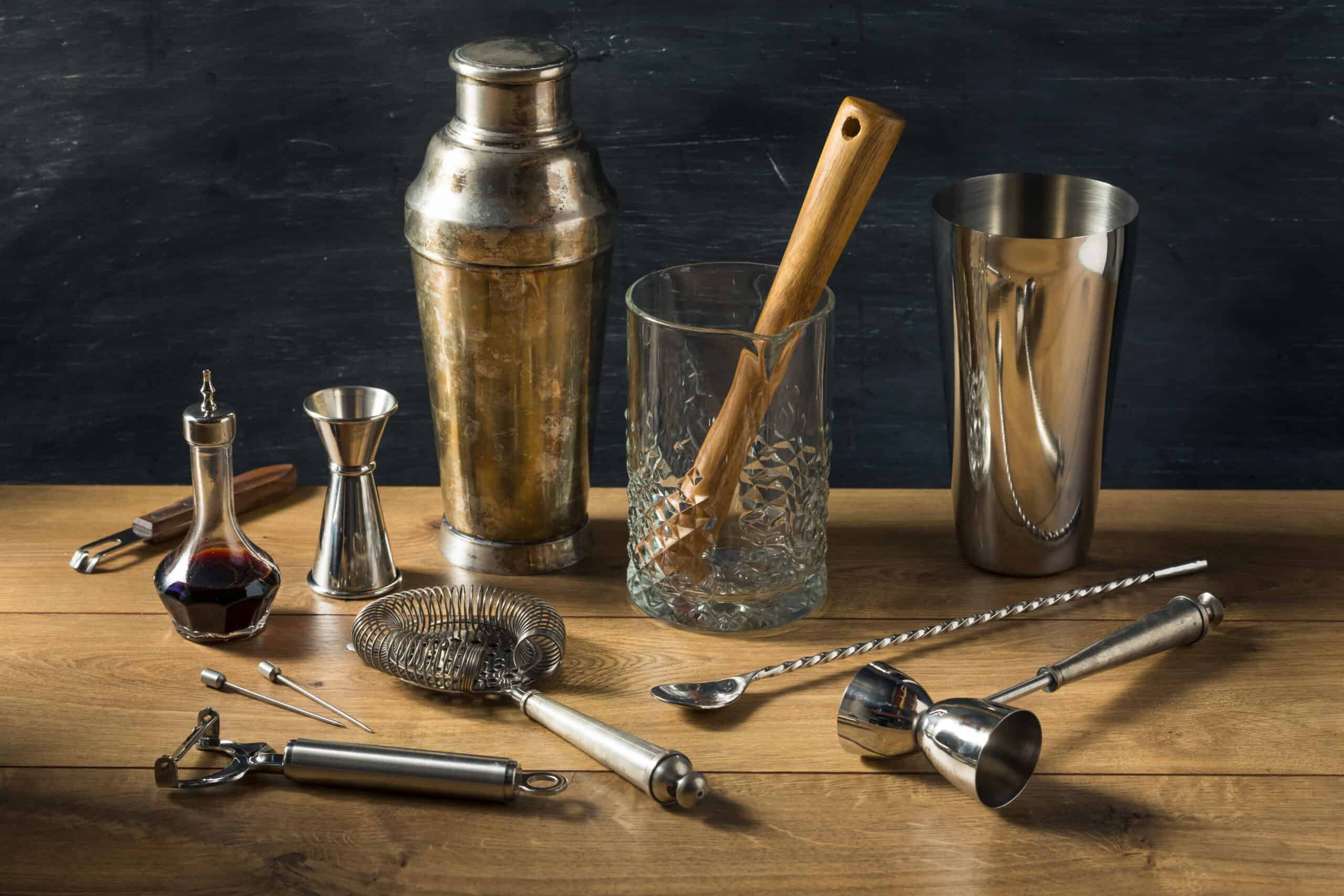
Fast forward to the 20th century and the more modern ‘cocktail’ was starting to make an appearance. Many bartenders faced strict laws back then but continued to master their craft in more underground locations. Popular drinks such as gin and tonic were invented during this period.
Today, bars are everywhere. There are now hundreds of bars and cocktail lounges across the world. The modern-day bartender is a craftsman; an artist is skilled in mixology and can produce drinks that would have been unheard of before.
Bartending equipment has also come on in leaps and bounds since the early days of speakeasies. Today, it’s not just about what you know, but how well-equipped your bar setup is too. This article will share some tips for setting up a home or professional bar with everything needed to become an expert mixologist.
What do you need to set up a bar?
So, what do you need to set up a bar? The first thing to consider is the space available. You’ll need a bar area that’s around three feet wide and at least four deep, with plenty of shelving or cupboards for storage below. This will depend on how many staff you want during service periods too.
Ideally, you should also have a sink nearby so glasses can be washed quickly as they’re used – this will save time later when cleaning up between customers. A special glassware dishwasher is also advisable. The next consideration is what drinks you want to serve as well as the ingredients needed to make them all. For example: do you need cocktail shakers? Cocktail strainers? Jiggers?
Then you’ll need the alcohol. You’ll need a range of spirits such as Vodka, Gin, Tequila, Rum, and so on. Everything for the most popular cocktails. Plus liqueurs – Amaretto or Cointreau for instance, as well as bitters such as Angostura (for an Old Fashioned). And mixers too. And ice.
Ideally, you’ll want to have all of these ready before your grand opening. There are also different types of glasses depending on what type of drink it is; pint glasses for beers, wine glasses for wines… You get the idea! Lastly, garnishes. These are there to make drinks look fancier but some need preparation: olives should be sliced beforehand, and lemon and lime wedges will also need to be cut.
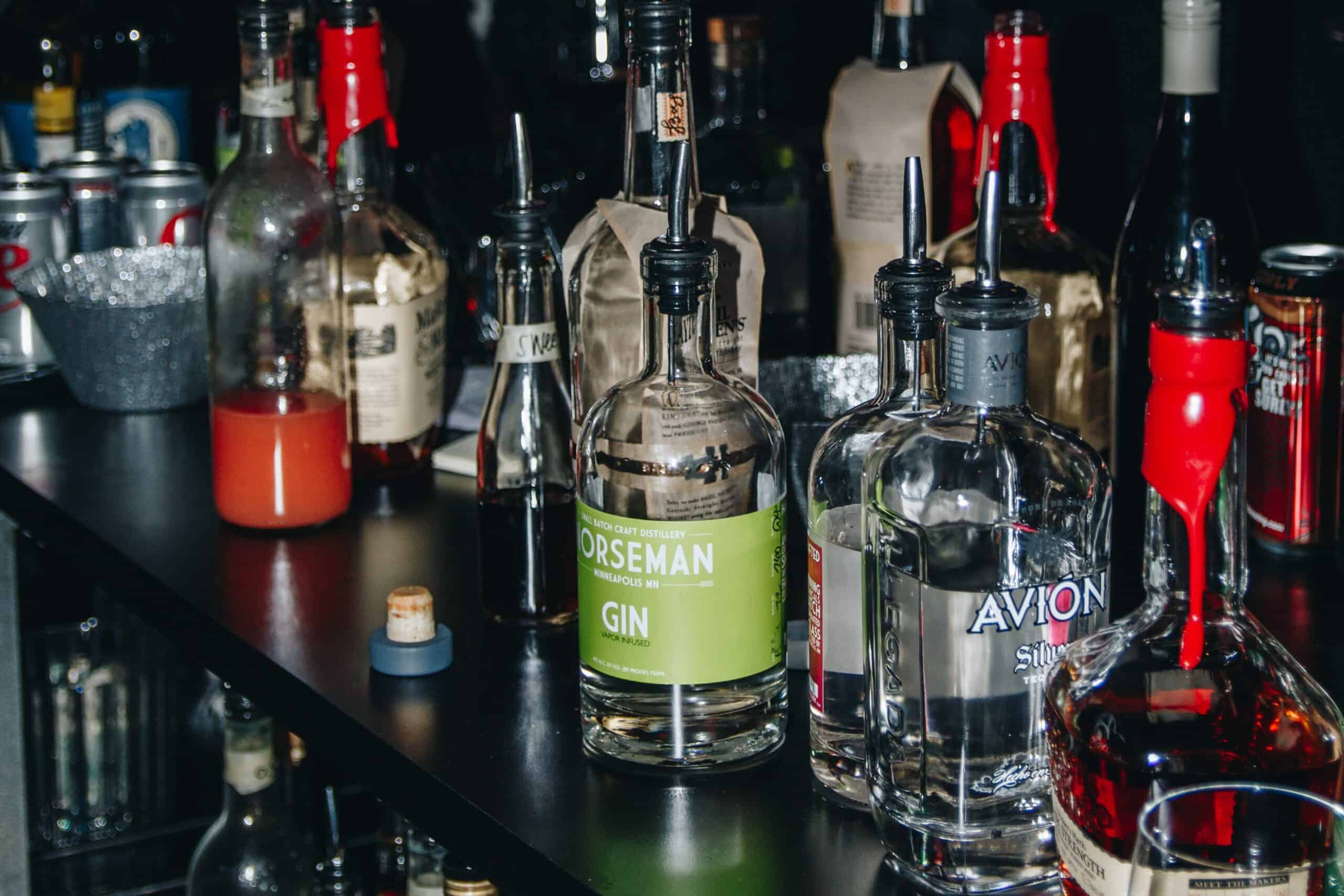
What is the Best Bartending Equipment for Your Bar?
So, now that we’ve run over a few of the basics, these are the necessities that most bars will need before they are set up.
- Bar Blade
- Wine Knife/Wine Key
- Lighter
- Wine Glass Rimmer
- Fruit/Juice Press
- Muddler
- Knife and Chopping Board
- Jigger
- Boston Shaker
- Speed Pourers
- Bar Spoon
- Hawthorn Strainer
- Fine/Tea Strainer
- Ice Accessories
- Pens
Let’s dig into each of these in a bit more detail.
Bar Blade
A bar blade is a tool used for opening beer bottles quickly, or for other improvised uses. Bar blades are typically made of stainless steel but they also come in ceramic or bamboo versions.
Wine Knife/Wine Key
A wine key might sound like an old-fashioned device – it’s not! A good wine key tool will help you open up bottles of wine with ease. There are different types of wine keys: those specifically designed for cork extraction, corkscrews with serrated edges which help to remove the foil and cork, as well as wine keys with a knife blade to help open bottles.
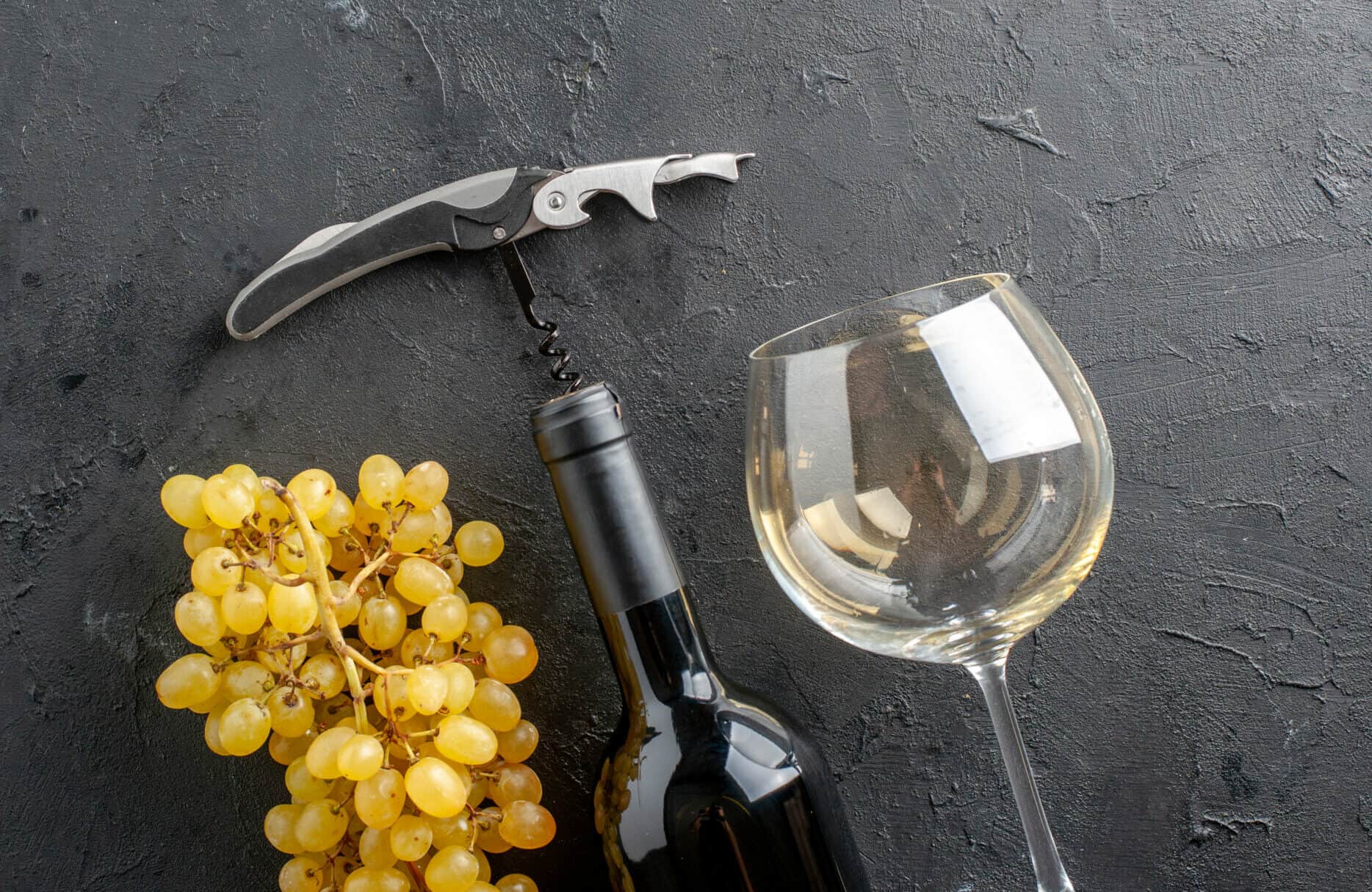
Lighter
You may think this is a strange tool to have behind a bar, but a lighter can be used for flaming orange or lemon zest, or for lighting candles to set a romantic mood.
Wine Glass Rimmer
A wine glass rimmer is an essential tool in any bartender’s arsenal. It can be used to make salt-rimmed cocktails or other drinks that have been “coated” with sugar around the rim of the glass. A good example would be tequila sunrise or a margarita: these are typically served in glasses with salted rims.
Fruit/Juice Press
This incredibly useful tool used in bars or restaurants presses out all of the liquid from all different kinds of fruit It’s a massive timesaver when it comes to adding fresh juice to cocktails as it can take a while to extract a lot of juice with a typical juicer.
A bar-standard fruit press should be big enough to fit a small orange. They’re usually cheap, easy to clean, and every bar (home or commercial) should have at least one of these.
Muddler
A muddler is usually made of wood but will also come in plastic or metal versions depending on what type of drink you are preparing. It’s usually used to mash fruit or sugar to put into cocktails. A muddler can be seriously fun to use and a very unique type of stress release – it’s effectively the pestle and mortar of the bartending world. It can also be used for crushing ice if you wanted to.
There are several options when it comes to buying a muddler – the flat bottom is better for muddling sugar, whereas the cerated bottom is better for crushing fruit as you’re able to easily extract the oil from the rind.

In terms of material, you’ll usually have wooden, metal, or plastic options. Plastic and wood are both great; metal on its own can be risky as, if you’re muddling in a glass, there’s a chance it might shatter. But metal with a rubber tip can also work well.
Knife and Chopping Board
A good knife and chopping board are bartending essentials. How else will you be able to slice lemons and limes, or cut oranges in half? But it’s not just citrus fruits that you’ll find on a bartender’s chopping board.
All kinds of fruits and veggies will likely make an appearance behind a bar, from cucumbers to strawberries or even tomatoes. And trust me, if you’ve ever tried to cut a tomato with a bunt knife before, you’ll know the importance of a good quality one.
A chopping board is a given to help protect your surfaces. It will also help keep your knife sharper for longer. You could either opt for a wooden board or a plastic one – plastic is easier to clean, but a wooden board has a more appealing look.
Jigger
A jigger is a handy measuring tool that can be found behind almost every bar. It’s used for making accurate measurements when pouring hard alcohol. It’s the quickest way to get a precise measurement of how much spirit is going into your cocktails. Some more experienced bartenders might free-pour, but a jigger will always give you the exact measurement.
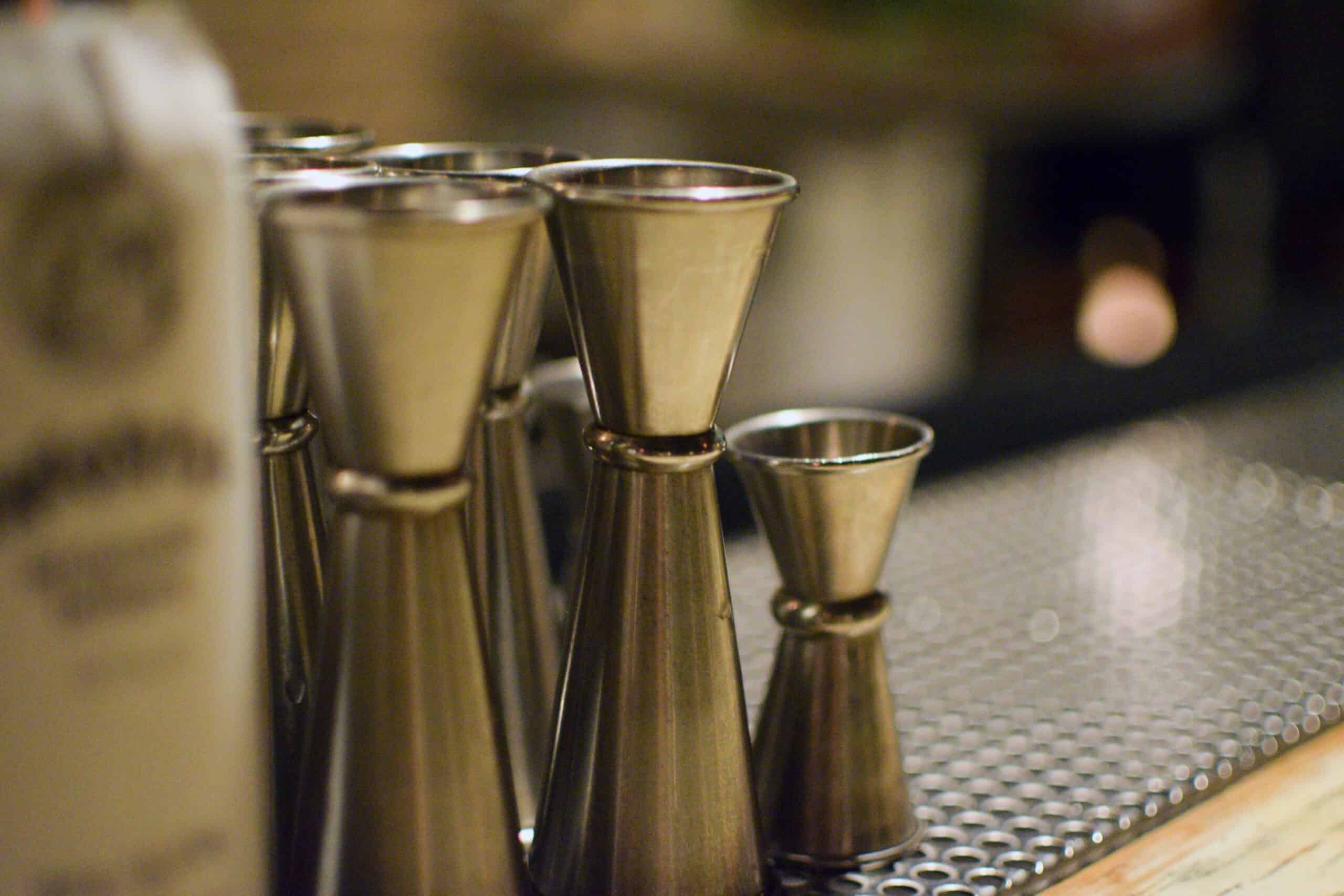
A jigger is typically made out of metal or plastic, with gradations marked off along the side. A standard version has two different cups at either end: one measures shots (or one ounce) while the other is four ounces.
Boston Shaker
Another key part of a bar is the cocktail shaker. This is usually the Boston Shaker, a two-piece drink mixer with different-sized metal cups. Each end of the Boston Shaker can be bashed together at an angle that creates a tight seal, locking in the drink while you shake it. Shaking both helps to quickly cool down the alcohol (when it mixes with the ice) and mix the drink’s ingredients together.
The Boston is ideal for those who frequently mix drinks as it’s fast, easy to use, and easy to strain. It can also double up as an ice scooper, or a mixing vessel for stirred cocktails.
There are typically two types of Boston Shaker that you’ll see online – a glass shaker and a tin shaker. Whilst the glass one does look snazzy, you’re usually better off going with the tin, as it lasts longer, is more durable, and has no risk of shattering after extended use.
Speed Pourers
These handy little nozzles certainly help speed up the drink-making process. Speed Pourers are the spouts that you find at the end of bottles. They make pouring drinks easy and quick, and allow you to control the flow of a bottle’s pour.
Bar Spoon
Usually used for stirring drinks, a bar spoon is a special, typically twisted spoon with a flat, circular end. You can buy other designs of bar spoons, but this type makes layering drinks much easier, especially if you’re using a deep glass.
The spoon is used chiefly for stirring drinks but can also be great for adding ingredients without making a mess. The spoon is also an accurate ½ teaspoon (25ml) measurement, so it’s also useful for measuring small amounts of ingredients.
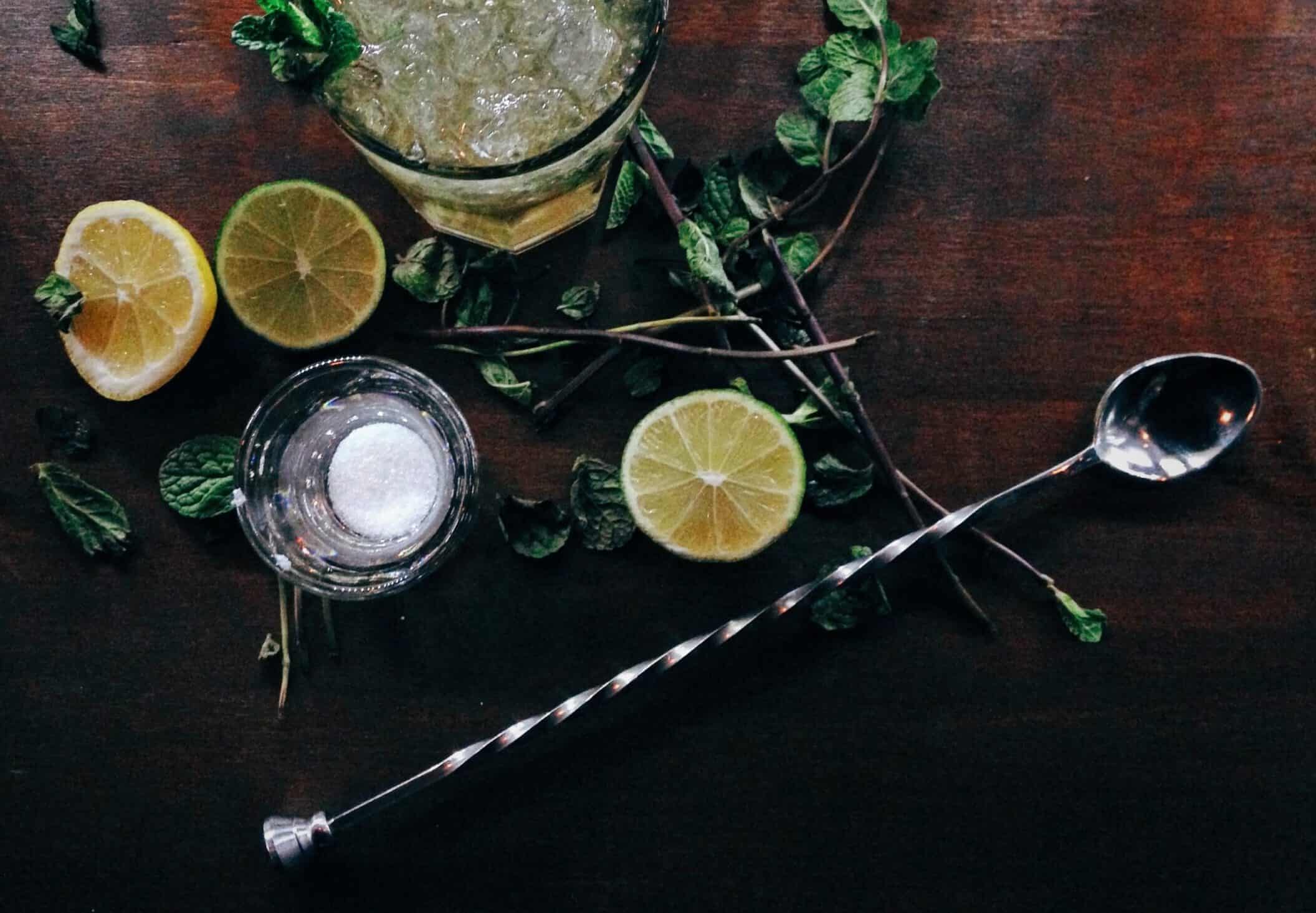
Hawthorne Strainer
Strainers are another essential piece of bartending equipment. You’ll usually find a Hawthorn Straine in most bars alongside the Boston Shaker. Both tools pair together pretty well.
This little must-have is commonly used for straining out the pulp from juicing fruits. It has tiny holes and can catch the smallest pieces of fruit – which makes for a more pleasant drinking experience, and makes drinks look better too.
Fine/Tea Strainer
No matter how good your Hawthorn Strainer, it won’t always get everything. This is where the fine strainer comes in. This is a handy little gadget that will prevent even the smallest pieces of pulp, ice shards, or even tiny seeds from getting into the drink.
Ice Accessories
A crucial part of a drink is the ice. Many first-time bar owners might forget this, but ice can make or break a drink. It both cools down the drink and dilutes the alcohol – both essential for making the perfect cocktail.
Make sure you remember an ice bucket and you’ll also need ice tongs to properly and safely handle ice. Don’t use your hands – that’s unhygienic – and using glass can be dangerous because shards of glass might break off in the ice and then be impossible to find. So be sure to invest in either an ice scoop, proper tongs, or you could always use your Boston Shaker if you don’t have either.
Pens
If you’ve ever worked in hospitality, you’ll understand the importance of having multiple pens handy. From jotting down orders to making notes of stock that needs ordering, make sure you have at least 2 pens behind the bar.
Different types of glasses
As well as equipment for making the actual cocktails, it’s important not to forget where you’re going to put the drink once you’ve made it. A key part of any beverage is in the presentation. You’ll need a selection of glasses for every different type of drink, from a Scotch on the rocks to the classic Martini. These are some of the glasses that every bartender should typically find on their shelves:
Highball
A highball is a tall glass that is used to serve long drinks like Gin and Tonics or Vodka Sodas. A highball glass can typically store 8-12 oz. of liquid and is used for cocktails like long-island iced tea or tequila sunrise.
Martini
The Martini glass is a triangular bowl-shaped cocktail glass that is typically used to serve drinks such as Gin or Vodka martini. They come in various sizes but the traditional glass will only hold about 4oz of liquid.

Flute
Tall and thin, the flute glass is usually reserved for champagne or sparkling wine. These glasses typically hold about 12oz of liquid and have a tall, narrow shape that prevents carbonation from escaping too quickly. The shape also prevents hands from warming up the contents of the glass.
Pint Glass
This is what your favorite pint at the local pub will come in. This type of drinking vessel holds 16-20 ounces worth of liquids and has a wide shape for easy drinking. Typically for holding lager, beer, ale, or soft drinks, the pint glass comes in various shapes and sizes and is usually branded depending on the contents.
Shot Glasses
Shaped like miniature versions of the rock’s glass, these glasses are designed to allow the drinker to consume small amounts of pure spirit or tiny cocktails in one gulp. There are a few varieties to choose from (like the shooter) but they typically hold 0.8 – 1.70 oz worth of liquid. They can also double up as a jigger.

Collins
Collins glasses are a great option for serving up tall, refreshing drinks. They are similar to the Highball, except taller and thinner, at 2 1⁄2 inches diameter by 6.75 inches in height. They hold around 10-14 oz. of liquid and are usually used for cocktails like Tom collins.
Coupe
Looking like an upside-down bowl on a stem, the coupe glass is great for serving mixed drinks like daiquiris, although it was originally used to hold the champagne. It is a small glass, (although you can get larger ones), and holds about 6 to 8 oz of liquid.
Rocks
The rocks glass is a common drinkware item for pubs or home bars – they are used to serve drinks such as Whiskey Sours or Gin and Tonics on ice cubes (rocks). It looks like an old-fashioned tumbler with straight sides instead of curved ones. They come in various sizes but will usually only store up to 16 ozs of liquid.
Margarita
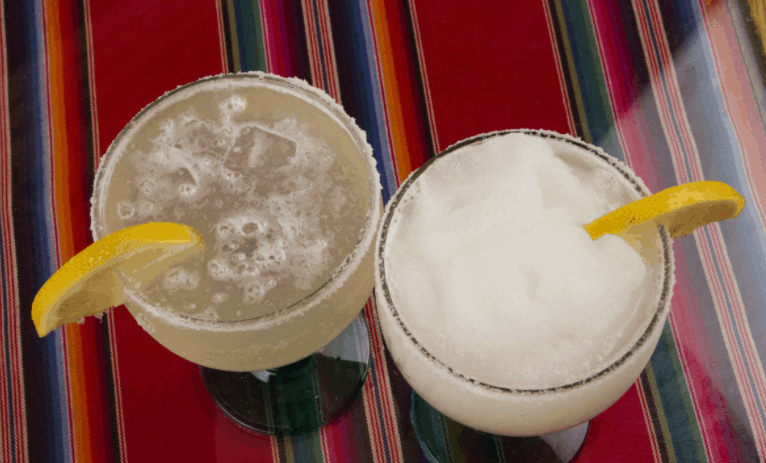
The Margarita is a classic – and so is its glass. A variation of the coupe glass, it’s mainly used to served the tequila-based beverage. Although it can sometimes also be used for starters like prawn cocktails or desserts like mousses.
Wine Glass
When you’re investing in all these fancy different glasses, don’t forget about the good old wine glass. It comes in a few different sizes depending on the size of the serving and the amount of wine in the glass but is all generally a few inches taller than they are wide.
The lighter, more delicate wines usually need to be served at cooler temperatures so we recommend serving them from these smaller glasses. The smaller the glass, the less surface area it will have, and it will therefore keep your drink cooler for longer. It’s also important to serve heavier reds out of this type of glass because it keeps them at room temperature for longer and is ideal for bigger volumes of liquid.
Mixing Glass
Not so much a glass you’d drink out of, but still an important piece of bartending equipment, the mixing glass is used for mixing ingredients and muddling drinks.
The mixing glass is also very useful when you want to make a drink with ice. It’s a perfect size and shape for most cocktails, and is great for giving drinks time to chill properly before serving. A proper mixing glass should be stout, study, and have a small spout for pouring.
Best Use Tips – Top Advice on Investing in Bar Equipment
When it comes to stating up a bar, the likelihood is, you may think you don’t need all of this stuff right away. But, it’s also more than likely that you’ll end up needing it much sooner than you think. Especially if you’re going for a professional standard.
So, I recommend getting every single item on this list, even things you may not think you need. Trust me, you’ll be surprised.
If you’re just looking at opening a home bar, you can buy plenty of useful tools on the internet. A simple cocktail-making kit might be all you need at this early stage. Once you have this, you can cross the other items off your list as and when they come up. But, a simple kit will get you started, and you’ll still be able to make the basics.
Once you’ve got all your bartending equipment, it’s time to start learning how to use it.

It’s a good idea to learn how to make a few popular cocktails before you open your bar. Simple recipes like a Mojito, Margarita, Cosmopolitan, or Pina Colada; there are all common bar orders, and they are going to come up sooner or later.
This will also give you practice with the presentation of drinks, using tools like the fruit press (to squeeze fresh lime juice for your Mojito), Boston Shaker, and Strainers. You’ll also start learning recipes and which drinks go in which glasses. Before long, it will become second nature.
Although you’re opening a commercial bar, it’s also a good idea to invest in a cocktail recipe book. You can buy a simple one on Amazon, and it will come in handy when customers ask for orders you’re not familiar with, and for training staff members later down the line.
You can buy most of this stuff online. But if you prefer to see things before you buy them, then there are plenty of specialty bartending stores or breweries that will sell professional equipment. However, it’s always worth investing in quality items.
That $20 complete cocktail kit might look tempting, but shoddy equipment leads to sub-par service and, ultimately, you may end up having to replace it in 6 months anyway. Investing in high-quality barware will not only help you do your own bartending better, but the right equipment also makes an appealing addition to any bar and is guaranteed to last for many years.
Then again, if you’re only looking for bar equipment to make yourself a quick cocktail on a Saturday night or you’re a bit strapped for cash, then the $20 kit might be exactly what you need. You can always upgrade down the line later if you need to.
The Best Bartending Equipment for Setting Up a Bar
Now that you know what you’re looking for, here are a few of our top bartending equipment recommendations:
Cocktail Kingdom Koriko Shaking Tins
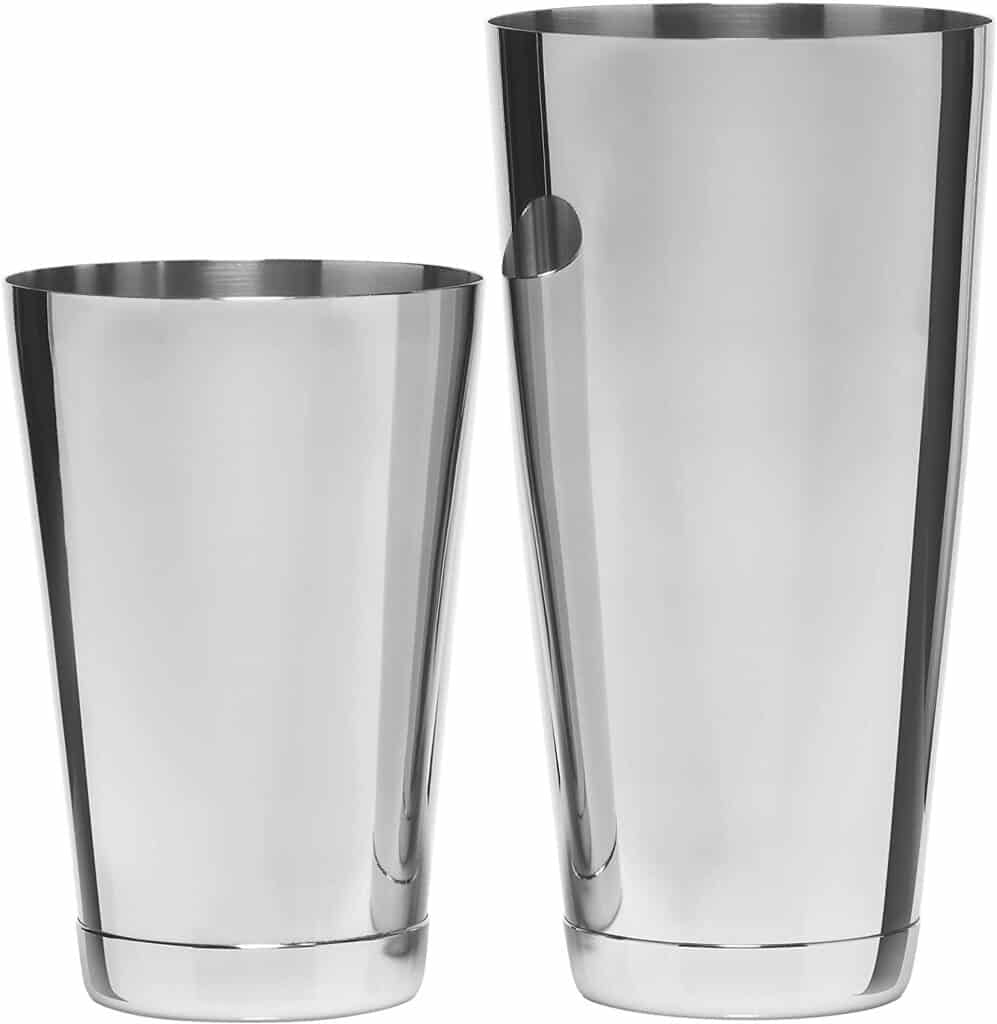
A favorite among bartenders, the Koriko tins are a top choice for shaking drinks and frequently appear in many other best-of bar equipment lists.
Designed for a tight fit and easy shaking, the larger tin can hold 28 ounces of liquid, while the smaller one can hold just 18 oz. Together, they can hold two cocktails. They are completely dishwasher safe and come in copper, gold, or stainless steel plating.
Hawthorne Bar Strainer By Modern Mixologist
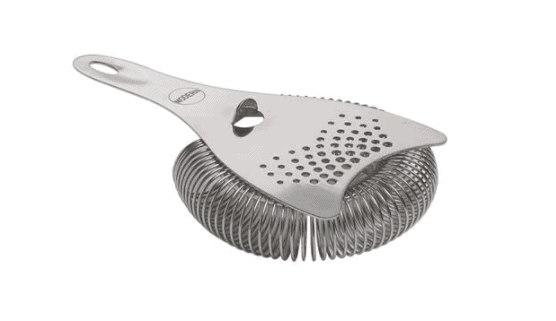
Designed by professional bartenders, Modern Mixologist’s Hawthorn Strainer is durable, high-quality, and will last a lifetime if you take good care of it.
It’s medium-sized, for more comfortable holding, and made from heavy-duty stainless steel. The superelastic springs fit most cocktail shakers without trouble and are easy to apply. For the perfect cocktails, you need to get this Hawthorne strainer.
OXO SteeL Double Jigger

This OXO Jigger is made of durable stainless steel and nylon which makes it highly durable. Like much of this other bartending equipment, this jigger will last for years to come. This product also has a handy non-slip grip to minimize spills and accidents. It has a double-sided measure for easy usage – one side of the jigger is 1 – 1/2 oz capacity, other side measures 1/4 oz, 1/2 oz, and 1 oz increments.
A Bar Above 12 Inch Cocktail Muddler
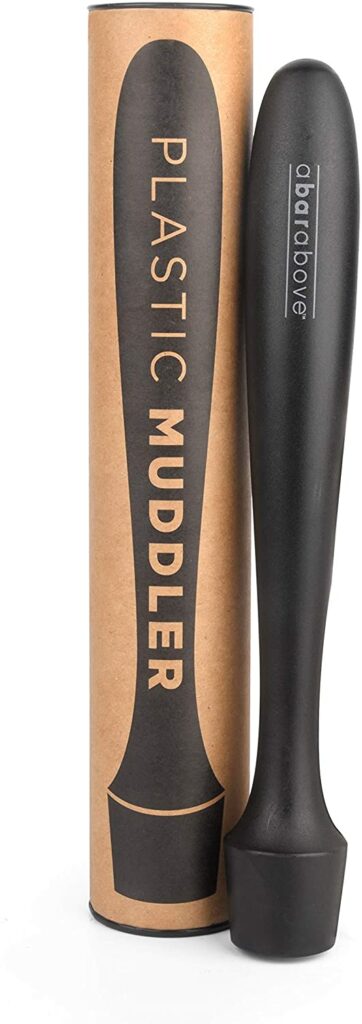
Great for professional bartenders, this plastic muddler is perfect for enhancing the flavors in your drinks. At 12 inches, it’s one of the longest you’ll find on the market, and the smooth end prevents herbs from being broken down too much – over-muddling can turn them sharp and bitter, so this is great for newbies and busy professionals alike.
The muddler is made from long-lasting plastic and created for comfort and to reduce hand stress – which you’ll need if you’re muddling many drinks each night. It’s also dishwasher safe, and strong enough to crush ice.
FAQs
Question: What are the four most common bar supplies accessories?
Answer: The most common bartending accessories are those listed above – a cocktail shaker, a strainer, a jigger, and a muddler. Each is essential to creating beautiful beverages and, if you can only have four tools on your bar, make it these.
Question: How important are bartending tools and equipment?
Answer: Let’s use the tools above as an example. The cocktail shaker is a container that mixes two liquids – it’s usually made of metal or glass. A strainer has an opening with small holes and it can strain out unwanted pieces from your drink – like fruit pulp or ice cubes. The jigger is used to measure drinks precisely by giving you one ounce at a time, while muddlers are used to enhance flavors and crush herbs. Bartending equipment is incredibly important as it enhances the experience of bartending – without this equipment, you’re effectively just pouring ingredients into glasses!
Question: What are the 6 basic cocktails?
Answer: The 6 basic cocktails every bartender should know are the Sidecar, Whiskey Highball, Martini, Flip, Daiquiri, Old Fashioned. Each of these uses a slightly different cocktail-making method and falls into a different category.
These are the basic ingredients for each:
• Sidecar – 1 1/2 oz Courvoisier Cognac, 1 oz Cointreau or Triple sec, orange liqueur (could be orange twist Cointreau), and lime juice.
• Whiskey Highball – 2 oz Scotch whiskey, 6 oz cold soda water, ice, lemon wedge.
• Martini – 2 oz gin with 3/4 oz of dry vermouth, shaken until cold and strained into a Martini glass. Optional olive garnish or lemon wedge.
• Flip – 2 oz spirit, fortified wine or brasserie Blanche de Chambly beer, lemon juice, 2 tsp sugar, raw egg white mixed in a blender then strained to remove the frothy top layer. Add a dash of nutmeg and serve.
• Daiquiri – 2 oz light, white rum such as Bacardi Silver Dry Rum, 3/4 oz of lime juice, 1/4 oz sugar syrup, or simple syrup, served with a lime wedge.
• Old Fashioned – 2 oz American whiskey or Bourbon, 2 dashes of Angostura bitters, and one sugar cube. You can also make this by diluting the bitters with orange peel soaked for 12 hours in simple syrup and water.
Conclusion
Overall, setting up a bar can be a challenge, but having a plan is the key to success. This bartending equipment list can go a long way to making sure your bar is well-stocked and successfully running. But, of course, the best way to learn about bartending and setting up a bar, is to do it. Hands-on experience is priceless, and the more drinks you make, the better you’ll become at making them.
We’ve outlined all of the essentials and must-haves for setting up your home or professional bar so that you’re ready to serve drinks in no time at all. Whether you need help with stocking your alcohol cabinets, choosing the best glassware for various types of cocktails, or just want some advice on how to make world-class drinks like an expert bartender – we’ve got you covered!
Continuously reading blog posts like this one will help you become an expert on bar setup and bartending techniques in no time, which will leave you and your customers in high spirits.

